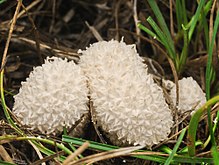
Puffballs are a type of fungus featuring a ball-shaped fruit body that bursts on contact or impact, releasing a cloud of dust-like spores into the surrounding area. Puffballs belong to the division Basidiomycota and encompass several genera, including Calvatia, Calbovista and Lycoperdon. The puffballs were previously treated as a taxonomic group called the Gasteromycetes or Gasteromycetidae, but they are now known to be a polyphyletic assemblage.

Lycoperdon is a genus of puffball mushrooms. The genus has a widespread distribution and contains about 50 species. In general, it contains the smaller species such as the pear-shaped puffball and the gem-studded puffball. It was formerly classified within the now-obsolete order Lycoperdales, as the type genus which, following a restructuring of fungal taxonomy brought about by molecular phylogeny, has been split. Lycoperdon is now placed in the family Agaricaceae of the order Agaricales.
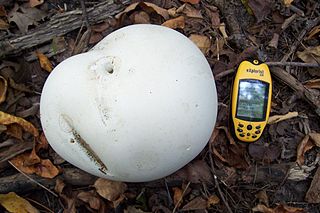
Calvatia gigantea, commonly known in English as the giant puffball, is a puffball mushroom commonly found in meadows, fields, and deciduous forests in late summer and autumn. It is found in temperate areas throughout the world.

Lycoperdon perlatum, popularly known as the common puffball, warted puffball, gem-studded puffball or devil's snuff-box, is a species of puffball fungus in the family Agaricaceae. A widespread species with a cosmopolitan distribution, it is a medium-sized puffball with a round fruit body tapering to a wide stalk, and dimensions of 1.5 to 6 cm wide by 3 to 10 cm tall. It is off-white with a top covered in short spiny bumps or "jewels", which are easily rubbed off to leave a netlike pattern on the surface. When mature it becomes brown, and a hole in the top opens to release spores in a burst when the body is compressed by touch or falling raindrops.

Lycoperdon umbrinum, commonly known as the umber-brown puffball, is a type of Puffball mushroom in the genus Lycoperdon. It is found in China, Europe, Africa, and North America.
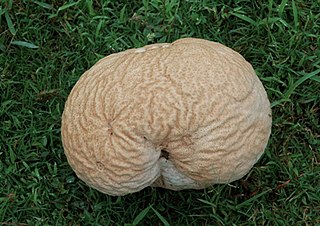
Calvatia craniiformis, commonly known as the brain puffball or the skull-shaped puffball, is a species of puffball fungus in the family Agaricaceae. It is found in Asia, Australia, and North America, where it grows on the ground in open woods. Its name, derived from the same Latin root as cranium, alludes to its resemblance to an animal's brain. The skull-shaped fruit body is 8–20 cm (3–8 in) broad by 6–20 cm (2–8 in) tall and white to tan. Initially smooth, the skin (peridium) develops wrinkles and folds as it matures, cracking and flaking with age. The peridium eventually sloughs away, exposing a powdery yellow-brown to greenish-yellow spore mass. The puffball is edible when the gleba is still white and firm, before it matures to become yellow-brown and powdery. Mature specimens have been used in the traditional or folk medicines of China, Japan, and the Ojibwe as a hemostatic or wound dressing agent. Several bioactive compounds have been isolated and identified from the brain puffball.
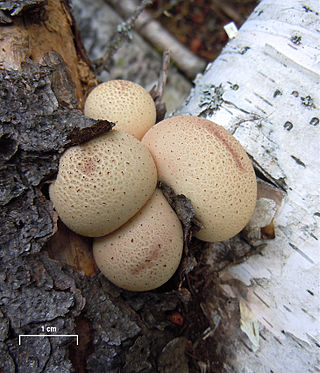
Apioperdon pyriforme commonly known as the pear-shaped puffball or stump puffball, is a saprobic fungus present throughout much of the world. Emerging in autumn, this puffball is common and abundant on decaying logs of both deciduous and coniferous wood. It is considered a choice edible when still immature and the inner flesh is white. It is often called Lycoperdon pyriforme, but was transferred to Apioperdon in 2017 based on phylogenetic and morphological differences. It is the only species in the genus.

Podaxis pistillaris is a very distinctive relative of the puffballs. It is commonly known as the desert shaggy mane, as it bears a superficial resemblance to the shaggy mane, Coprinus comatus; this species lacks the latter's deliquescing gills, however, and the two are not closely related. It grows to 15 cm high and has a hard, woody stem. The large cap, which protects the blackish spore-bearing tissue, splits, and usually falls away at maturity, allowing the spores to be dispersed by wind. Large numbers may appear after soaking rains. It thrives in deserts and semi-deserts of Australia and other countries, often found on termite mounds in South Africa. In the Hawaiian Islands, it is frequently encountered along roadsides and in disturbed areas on the dry sides of the islands, especially in the Kona area of Hawaii and the Kihei area of Maui.

Bovista plumbea, commonly known as the tumbling puffball, tumbleball, or paltry puffball, is a small puffball mushroom commonly found in Western Europe and California, white when young and greyish in age. Easily confused with immature Bovista dermoxantha, it is attached to the substrate by a tuft of mycelium.

Handkea utriformis, synonymous with Lycoperdon utriforme, Lycoperdon caelatum or Calvatia utriformis, is a species of the puffball family Lycoperdaceae. A rather large mushroom, it may reach dimensions of up to 25 cm (10 in) broad by 20 cm (8 in) tall. It is commonly known as the mosaic puffball, a reference to the polygonal-shaped segments the outer surface of the fruiting body develops as it matures. Widespread in northern temperate zones, it is found frequently on pastures and sandy heaths, and is edible when young. H. utriformis has antibiotic activity against a number of bacteria, and can bioaccumulate the trace metals copper and zinc to relatively high concentrations.

Bovista aestivalis is a species of small puffball in the family Agaricaceae. It is generally found in the coastal regions of California, but was reported from Korea in 2015. This fungus is often confused with Bovista dermoxantha, because of its similar peridium, and Bovista plumbea. The surest way to tell the species apart is to examine the spores and exoperidium, respectively, with a microscope.

Calvatia sculpta, commonly known as the sculpted puffball, the sculptured puffball, the pyramid puffball, or Sierran puffball, is a species of puffball fungus in the family Agaricaceae. Attaining dimensions of up to 8 to 15 cm tall by 8 to 10 cm wide, the pear- or egg-shaped puffball is readily recognizable because of the large pyramidal or polygonal warts covering its surface. It is edible when young, before the spores inside the fruit body disintegrate into a brownish powder. The spores are roughly spherical, and have wart-like projections on their surfaces.

Lycoperdon echinatum, commonly known as the spiny puffball or the spring puffball, is a type of puffball mushroom in the family Agaricaceae. The saprobic species has been found in Africa, Europe, Central America, and North America, where it grows on soil in deciduous woods, glades, and pastures. It has been proposed that North American specimens be considered a separate species, Lycoperdon americanum, but this suggestion has not been followed by most authors. Molecular analysis indicates that L. echinatum is closely related to the puffball genus Handkea.

Lycoperdon pulcherrimum, commonly known as the long-spined puffball, is a type of puffball mushroom in the genus Lycoperdon. It was first described scientifically in 1873 by Miles Joseph Berkeley and Moses Ashley Curtis. The fungus is found in the southern United States.

Lycoperdon mammiforme is a rare, inedible type of puffball mushroom in the genus Lycoperdon, found in deciduous forest on chalk soil. It is found in Europe. The fruit body is spherical to pear shaped, at first pure white with slightly grainy inner skin and an outer skin which disintegrates in flakes that are soon shed, later ochre, chocolate-brown when old, up to 7 cm (2.8 in) in diameter.

Lycoperdon molle, commonly known as the smooth puffball or the soft puffball, is a type of puffball mushroom in the genus Lycoperdon. It was first described scientifically in 1799 by Dutch mycologist Christiaan Hendrik Persoon. The puffball is edible when the internal flesh is still white.
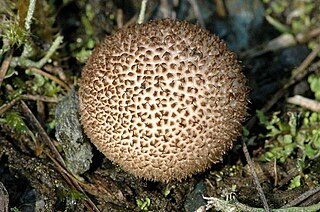
Lycoperdon nigrescens, with the synonym Lycoperdon foetidum, commonly known as the dusky puffball, is a type of puffball mushroom in the genus Lycoperdon. It was first described scientifically in 1794 by the Swedish naturalist Göran Wahlenberg. Visually similar to other species when young, it grows increasingly darker with age, and lacks the pronounced stipe that old Lycoperdon perlatum attain.

Handkea excipuliformis, commonly known as the pestle puffball or long-stemmed puffball, is a species of the family Agaricaceae. A rather large puffball, it may reach dimensions of up to 15 cm (5.9 in) broad by 25 cm (9.8 in) tall. Widespread in northern temperate zones, it is found frequently on pastures and sandy heaths.

Lycoperdon marginatum, commonly known as the peeling puffball, is a type of puffball mushroom in the genus Lycoperdon. A common species, it is found in Europe and North America, where it grows on the ground. It is characterized by the way that the spiny outer layer peels off in sheets.

Lycoperdon lividum, commonly known as the grassland puffball, is a type of puffball mushroom in the genus Lycoperdon. It is found in Europe, where it grows on sandy soil in pastures, dunes, and heaths, especially in coastal areas. It fruits in autumn. It was first described scientifically in 1809 by Christian Hendrik Persoon.
